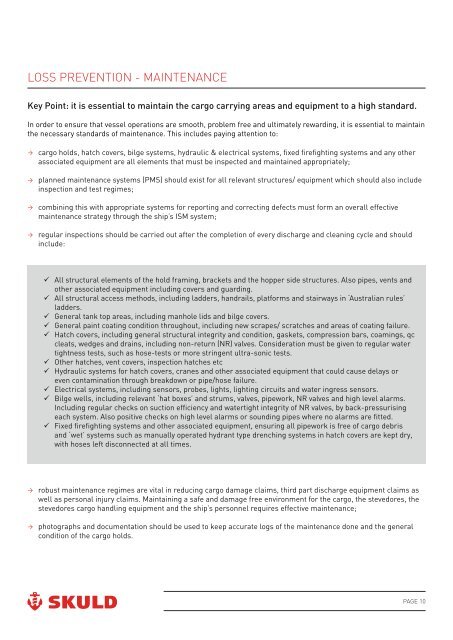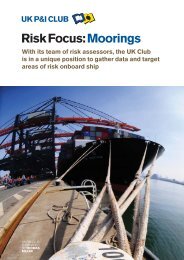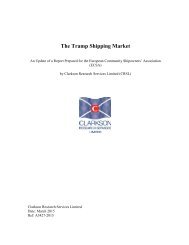Preparing cargo holds_ Loading solid bulk cargoes
Preparing cargo holds_ Loading solid bulk cargoes
Preparing cargo holds_ Loading solid bulk cargoes
Create successful ePaper yourself
Turn your PDF publications into a flip-book with our unique Google optimized e-Paper software.
LOSS PREVENTION - MAINTENANCE<br />
Key Point: it is essential to maintain the <strong>cargo</strong> carrying areas and equipment to a high standard.<br />
In order to ensure that vessel operations are smooth, problem free and ultimately rewarding, it is essential to maintain<br />
the necessary standards of maintenance. This includes paying attention to:<br />
´ ´ <strong>cargo</strong> <strong>holds</strong>, hatch covers, bilge systems, hydraulic & electrical systems, fixed firefighting systems and any other<br />
associated equipment are all elements that must be inspected and maintained appropriately;<br />
´ ´ planned maintenance systems (PMS) should exist for all relevant structures/ equipment which should also include<br />
inspection and test regimes;<br />
´ ´ combining this with appropriate systems for reporting and correcting defects must form an overall effective<br />
maintenance strategy through the ship’s ISM system;<br />
´ ´ regular inspections should be carried out after the completion of every discharge and cleaning cycle and should<br />
include:<br />
All structural elements of the hold framing, brackets and the hopper side structures. Also pipes, vents and<br />
other associated equipment including covers and guarding.<br />
All structural access methods, including ladders, handrails, platforms and stairways in ‘Australian rules’<br />
ladders.<br />
General tank top areas, including manhole lids and bilge covers.<br />
General paint coating condition throughout, including new scrapes/ scratches and areas of coating failure.<br />
Hatch covers, including general structural integrity and condition, gaskets, compression bars, coamings, qc<br />
cleats, wedges and drains, including non-return (NR) valves. Consideration must be given to regular water<br />
tightness tests, such as hose-tests or more stringent ultra-sonic tests.<br />
Other hatches, vent covers, inspection hatches etc<br />
Hydraulic systems for hatch covers, cranes and other associated equipment that could cause delays or<br />
even contamination through breakdown or pipe/hose failure.<br />
Electrical systems, including sensors, probes, lights, lighting circuits and water ingress sensors.<br />
Bilge wells, including relevant ‘hat boxes’ and strums, valves, pipework, NR valves and high level alarms.<br />
Including regular checks on suction efficiency and watertight integrity of NR valves, by back-pressurising<br />
each system. Also positive checks on high level alarms or sounding pipes where no alarms are fitted.<br />
Fixed firefighting systems and other associated equipment, ensuring all pipework is free of <strong>cargo</strong> debris<br />
and ‘wet’ systems such as manually operated hydrant type drenching systems in hatch covers are kept dry,<br />
with hoses left disconnected at all times.<br />
´ ´ robust maintenance regimes are vital in reducing <strong>cargo</strong> damage claims, third part discharge equipment claims as<br />
well as personal injury claims. Maintaining a safe and damage free environment for the <strong>cargo</strong>, the stevedores, the<br />
stevedores <strong>cargo</strong> handling equipment and the ship’s personnel requires effective maintenance;<br />
´ ´ photographs and documentation should be used to keep accurate logs of the maintenance done and the general<br />
condition of the <strong>cargo</strong> <strong>holds</strong>.<br />
PAGE 10




